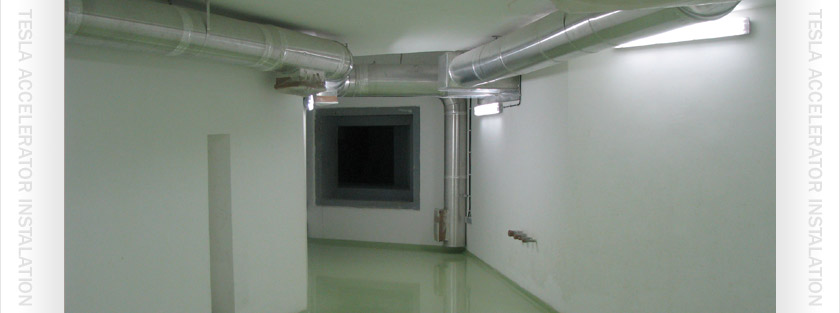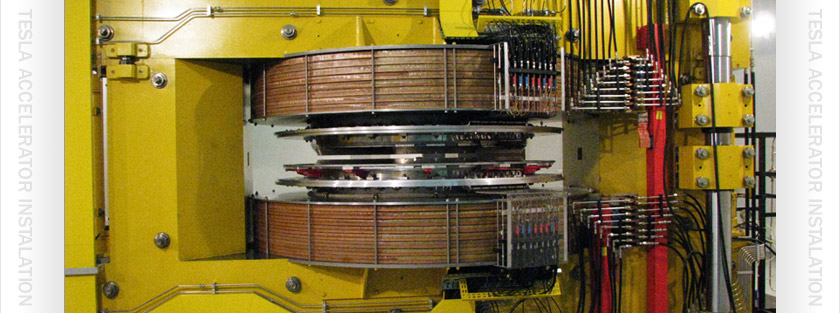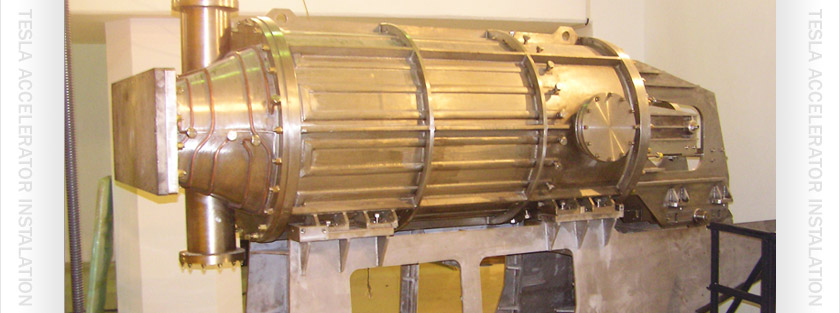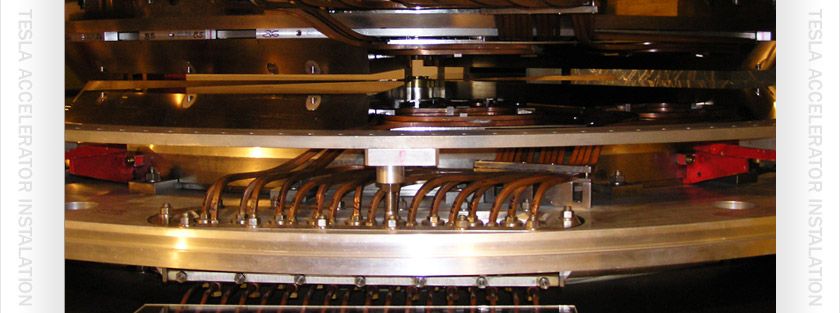 |
 |
 |
| The TESLA Accelerator Installation (TAI) is a facility for production, acceleration and use of ion beams in science and medicine. Its main part is the VINCY Cyclotron, which is a medium-sized isochronous cyclotron. The construction of TAI began in December 1989, on the basis of a special decision of the Government of Serbia. The strategic partner of the Vinča Institute of Nuclear Sciences in this endeavor is the Joint Institute. |
 |
However, the construction of TAI was going on with frequent and long delays, due to the irregular and insufficient financing. For example, in the period between June 1998 and September 2002 the construction was not financed at all. In November 2007 the Government of Serbia decided to stop the financing of the construction from the budget of Serbia. That decision was made on the basis of the report of a body whose members were incompetent for the field of construction and use of accelerators.
They completely neglected the opinions of three expert bodies that were formally responsible for controlling the realization of the endeavor. The first expert body was the TESLA Advisory Committee, which included five world experts in the field of construction of accelerators. Its Chairman was G. Plass, European Organization for Nuclear Research (CERN), Geneva, Switzerland. That expert body gave nine detailed reports on the construction of TAI to the Government of Serbia in the period of May 1992 and November 2004.
The second expert body was the TESLA Program Committee, which included seven world experts in the field of use of accelerated ion beams. Its Chairman was Yu. Oganessian, Joint Institute. That expert body gave three detailed reports on the programs of use of TAI to the Government of Serbia in the period between July 1996 and May 1998.
The third expert body was the Council for Following the Realization of the TESLA Project, which included 11 national experts appointed by the Ministry of Science of Serbia to follow the construction, use and preparations for use of TAI. It gave a detailed report on the status and perspectives of the construction and use of TAI to the Ministry of Science in September 2007. |
 |
| Also, 14 world experts in the field of construction and use of accelerators sent in October 2007 a letter to the Premier of the Government of Serbia in which they gave its opinion on the technological and scientific profile of TAI. Besides, company EKI Investment gave a detailed report on the profitability of the medical programs of use of TAI to the Ministry of Science in November 2006. All the mentioned opinions were positive. Up to the decision of the Government of Serbia from November 2007, the direct costs of the construction were EUR 14.77 million. The additional amount that was necessary for completing the construction was EUR 10.63 million. |
 |
| In January 2008 TAI was divided in three parts – the low energy, medium energy and high energy parts. Then, we took the obligation, within the Vinča Scientific and Technological Program, accepted for financing by the Ministry of Science of Serbia in the period between 2008 and 2010, to propose to the Government of Serbia what to do with the mentioned parts of TAI. Our final proposal about that is given in the separate text about the low energy part (FAMA), and in the following text, about the medium energy and high energy parts. |
 |
| Completion of construction of the medium energy part of the TESLA Accelerator Installation |
| The medium energy part of TAI is connected to the H4 building, which should have been used for basic and applied research and routine production of radiopharmaceuticals with ion beams from the VINCY Cyclotron. The direct costs of construction of this building were EUR 1.38 million (see the part of supplement 3 on the existing equipment). |
 |
 |
| We are proposing to the Ministry of Science and Technological Development, Ministry of Health and Government of Serbia to make the decision on completing the infrastructure works in the H4 building, and on purchasing a small isochronous cyclotron that would give the proton beam of the energy of 16,5 MeV and the remaining equipment needed for the routine production of radiopharmaceuticals for PET. |
| The most important radiopharmaceutical for PET is FDG, which contains radionuclide 18F, whose lifetime is 110 minutes. This diagnostic technique is applied very successfully in oncology, cardiology, neurology and psychiatry worldwide. |
| It must be emphasized that two medical centers in Serbia have already purchased the PET cameras, and that they operate with the imported radiopharmaceuticals. The plan of production of radiopharmaceuticals in the H4 building comprises the radiopharmaceuticals based on radionuclides 18F, 64Cu, 86Y and 124I, for PET, and those based on 123I, for single photon emission tomography (SPET), and 90Y, for therapy, and can also comprise the radiopharmaceuticals based on radionuclides 13N and 11C, for PET. This plan enables that all the equipment to be installed in the H4 building is used for basic, applied and developmental research in the fields of radiochemistry and radiopharmacy. This possibility is especially attractive for the researchers in the Vinča Institute who work in these fields. |
 |
 |
The financial resources needed for the realization of our proposal are EUR 3.57 million (see the part of supplement 3 on the requested equipment). This amount should be provided from the loan of EUR 200 million the European Investment Bank, Luxembourg, approved in March 2010 to the Government of Serbia for research and development. The alternative is that this amount is provided by a private investor. In June 2010 the Vinča Institute launched the initiative for separating the H4 building of TAI from the Institute and founding the company for production of cyclotron radiopharmaceuticals that would realize our proposal. |
The accepting of our proposal is not a condition for the realization of the project. However, if it is accepted and realized, that would enable a considerable widening of the activities comprised by its subproject (4). That widening would be focused on developing new radiopharmaceuticals for PET.
A brief description of the equipment comprised by our proposal is the following. The building is planned to be used for routine and experimental production of radiopharmaceuticals for positron emission tomography (PET), according to the regulations of good manufacturing practice (GMP). It has three levels of the total area of 651 m2. The equipment comprises a small isochronous cyclotron giving protons of the energy of 16.5 MeV with targets, two modules for synthesis of radiopharmaceuticals, two hot cells for modules for synthesis, a modul for dispensing radiopharmaceuticals, a hot cell for modul for dispensing, a system for quality control and a system for monitoring ionizing radiation. Also, the remaining infrastructure works in the H4 building should be finished. This equipment must satisfy the requirements for production of radiopharmaceuticals according to the regulations of good manufacturing practice (GMP). |
 |
| Completion of construction of the high energy part of the TESLA Accelerator Installation |
The high energy part of TAI comprises the VINCY Cyclotron, which was designed to give the proton beams of the energies of up to 73 MeV and the heavy ion beams of the energies of up to 34 MeV per nucleon, and four experimental channels – two for developing new materials and nanotechnologies, one for neutron research and one for proton therapy. The channel for neutron research would include a small subcritical fission nuclear reactor driven by the proton and deuteron beam. It should become the key facility for education in the field of nuclear energy in Serbia. The channel for proton therapy would be used for routine treatment of eye tumors, which is applied very successfully worldwide. The direct costs of construction of the high energy part of TAI were EUR 9.59 million (see the part of supplement 3 on the existing equipment). |
 |
| We are proposing to the Ministry of Science and Technological Development, Ministry of Mining and Energy, Ministry of Health, Ministry of Education and Government of Serbia to make the decision that the job of completing the construction of the Cyclotron VINCY and its four experimental channels is given to the Joint Institute through a special agreement between the Government of Serbia and Government of Russia. |
 |
| The realization of this agreement would be controlled by two expert bodies, which would be formed by the Government of Serbia. The first expert body would be the TESLA Technical Committee. The European Organization for Nuclear Research (CERN), Geneva, Switzerland, should participate in its forming. The activities of this expert body would be focused on achieving the high technological level of the delivered equipment. The second expert body would be the TESLA Program Committee. The International Atomic Energy Agency (IAEA), Vienna, Austria, should participate in its forming. The activities of this expert body would be directed toward achieving and maintaining the high quality and relevance of the programs of use of the high energy part of TAI. |
 |
 |
| The financial resources needed for the realization of our proposal are about EUR 16 million (see the part of supplement 3 on the requested equipment). This amount should be provided from the loan of USD 800 million the Government of Russia should approve in the near future to the Government of Serbia, as the amount for research and development. |
 |
| The accepting of our proposal is not a condition for the realization of the project. However, it should be emphasized that the experiments within its subprojects (2) and (3) that will be performed in the Joint Institute would be performed with the ion beams from the VINCY Cyclotron if it were commissioned. The accepting and realization of our proposal would enable a considerable widening of the activities comprised by subprojects (2) and (3). Also, that would enable the including of a large number of researchers from the Vinča Institute and the other scientific and educational institutions from Serbia and the surrounding countries in the user community of the high energy part of TAI, in the fields of new materials, nanotechnologies and nuclear technologies. Thus, the high energy part of TAI would become a large scale scientific and educational facility of South Eastern Europe. |
 |
A very brief description of the equipment comprised by our proposal is the following. The VINCY Cyclotron is a medium-sized isochronous cyclotron. Its magnetic structure comprises the ferromagnetic elements, main coils and correction coils. The diameter of the magnet pole is 2 m. The maximal magnetic induction at the center of the machine is 1,97 T. The radiofrequency system of the machine includes two resonators of the eigenfrequency in the range from 17 to 31 MHz. The maximal acceleration voltage is 100 kV. The injection system of the machine includes a light ion source, a heavy ion source and a transport line, enabling one to introduce ion beams into the machine axially. The machine has two extraction systems - a stripping foil system and an electrostatic deflection system. It was designed to deliver protons in the energy range from 22 to 73 MeV and heavy ions in the energy range from 3 to 34 MeV per nucleon. The experimental channels in which these ion beams would be used are the channel for proton therapy (H1), the channel for nanotechnologies (H2), the channel for analysis of materials (H3) and the channel for neutron research (H5). |
 |
|
|